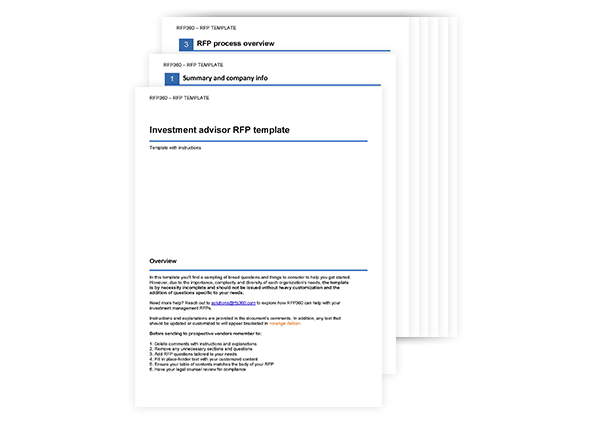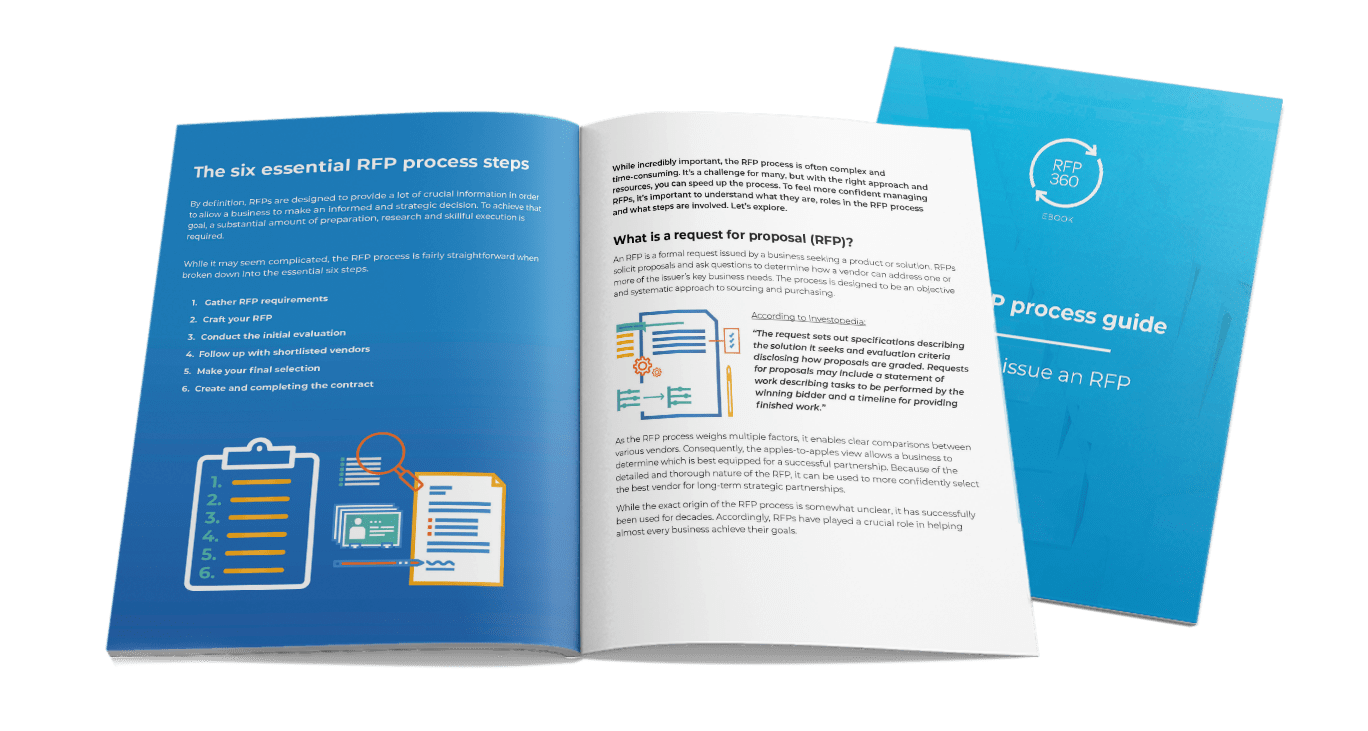When it comes to entrusting assets to a financial services firm, there’s a lot at stake. Investment committees and plan sponsors need to use a thoughtful, methodical process to select the best advisor. For many organizations, issuing an investment RFP is the best way forward.
When used properly, the RFP process clearly defines your organization’s needs, empowers data-based decisions and helps ensure you fulfill your fiduciary duty. With the weight of this responsibility in mind, it is essential to get it right.
So, in this post, we’ll explore everything you need to know about investment management RFPs. We’ll start with the basics of financial services and investment management RFPs. Specifically, we’ll cover the definition, the other names this type of RFP is called and why companies use them. Next, we’ll walk through what you need to know when you’re issuing an investment management RFP and best practices for success. And finally, we’ll share a sample investment management RFP template and several examples. With these you can see what the process looks like in action.

Investment RFP basics
Among financial services firms, requests for proposals (RFPs) are increasingly common. In fact, a recent survey reports 91 percent of asset managers say they struggle to meet RFP deadlines. While RFPs are normal in the financial industry, questions frequently arise.

What is an investment management RFP?
An investment management request for proposal (RFP) is a standardized, formal questionnaire used by institutional investors to gather information, evaluate options and select the right financial services partner to manage their funds.
Other names for investment RFPs
This kind of RFP falls into the financial services RFP category. Within the financial sector, investment RFPs go by many different names.
- Investment management RFP
- Investment RFP
- Asset management RFP
- Investment consultant RFP
- Investment advisor RFP
- Investment consultant RFP
As with all RFPs, there may be small nuances between each of these different types. However, you will also find a lot of overlap in their content. Essentially, they all serve the same purpose — to detail and organize the exchange of the information required to select an investment firm and engage their services.
NOTE: If you’re a financial services firm trying to find RFPs, it’s important to keep in mind all the different names they may be called. In addition, remember to carefully read the RFP requirements, selection criteria and minimum qualifications to ensure you understand the scope of the request.
Types of organizations that issue investment management RFPs
- Endowments
- Nonprofits
- Foundations and associations
- Businesses with 401(k) or 403(b) retirement plans
- Municipalities with pension plans
Writing an effective investment management request for proposal takes a unique combination of skills and experience. Unlike other RFPs, the finance or HR department typically writes and manages asset management RFPs, rather than procurement. For instance, an HR manager, portfolio manager, investment analyst or financial analyst may create an investment management RFP.
Roles involved in asset management RFPs
There may also be additional roles involved in the RFP. Most commonly, you’ll hear these terms.
Institutional investor
An institutional investor represents a group of investors, pools and invests funds on behalf of the members. Institutional investors create and issue investment management RFPs. However, any organization with assets they wish to invest may benefit from exploring financial service providers using an RFP.
Investment committee
Some organizations establish an investment committee to manage their RFP. This usually includes an odd number of people from different departments. For example, a 401K investment committee might include people from HR, legal and the executive team. This group of stakeholders works together to ensure that the advisor selection process is thorough, fair and unbiased.
Plan sponsor
Within the investment committee, the primary contact for the process is called the plan sponsor. They are responsible for gathering feedback and approving the contents of the RFP, answering vendor questions, reviewing proposal scoring and presenting recommendations to the board.
Why do investors issue RFPs?
As organizations and investors seek out partnerships to manage and grow their assets, they must consider a number of factors. Indeed, selecting an investment advisor is a tremendous responsibility. The organization relies on the investment committee to safeguard the interests of the organization or their employees that contributed to the fund.
So, the goal for any investment committee is to find the best possible financial advisor for the organization. Members of the investment committee are considered fiduciaries, meaning they have both a moral and legal obligation to act in the organization’s best interest. Indeed, if an organization fails to perform adequate due diligence and engages an unqualified or compromised investment advisor the plan sponsor, investment committee and company may be held liable.
Luckily, the RFP process provides a reliable framework to make informed decisions. Using an RFP ensures that all financial services firms are evaluated fairly using the same criteria. Consequently, this approach helps avoid unintentional bias and mitigate risk. Additionally, it enables you to weigh various decision factors, outline complex requirements, ensure transparency and create side-by-side comparisons. Ultimately, both the investing organization as well as the prospective firms benefit from the RFP process.
To explore the RFP process in more detail, check out this helpful ebook.

How to issue an investment management RFP
While each RFP is unique, they all use the same three-step process — RFP creation, administration and evaluation.
1. Creation
First, RFP creation includes defining the goals, requirements and priorities for the project. Next, using that information, write the RFP. Remember to include background information, objectives, RFP timeline, criteria and requirements.
Elements to include in your investment RFP
- Summary and company information
- Overview – Company name, address and RFP type
- Introduction – What are you looking for?
- Company background – Who are you? What do you do?
- Description
- Asset information – What kinds of accounts and balances are you investing?
- Oversight – Who is on your investment committee? Are in-person meetings required?
- Scope of services – What services do you need?
- Criteria – Compliance, services and experience requirements
- RFP process overview
- RFP timeline – When are follow-up questions and the proposal due? When will you make your final selection?
- Participants – Who are you inviting to the process?
- Questionnaire
- Vendor information – Company name, contact info, ownership, size
- Primary contact – Who is in charge of the RFP response?
- Basics and background – History, status, insurance coverages
- People – Information about the firm as a whole and the specific team that will service your account
- Philosophy – What is the firm’s approach to the topics and services you’re interested in?
- Process – How does the firm operate? What will interactions look like?
- Performance – How will the firm report results? Who will be involved? How often?
- Pricing – What are the costs associated with the requested services? Do they use a standard pricing model?
2. Administration
Next, in the administration step, you issue the RFP you’ve created. But, before you do that, you must select which firms to include in the project. Once you’ve selected your suppliers and issued the RFP, you will answer any follow-up questions. And, as your deadline approaches, it is helpful to send reminders to firms that have not yet responded.
3. Evaluation
Now, the last step — proposal evaluation and final selection. Due to the complex nature of investment management RFPs, this step is often time consuming. To save time, refer back to your initial RFP criteria.Use the requirements gathered from your internal discussions to guide your evaluation. In addition, you may consider using a vendor comparison matrix or applying a weighted scoring approach to focus on the most important sections of your RFP. Indeed, this is particularly important when engaging stakeholders or an investment committee in the scoring process because it ensures everyone is on the same page.
When making your final decision, keep the big picture in mind. Which firm has the best combination of experience, previous success and infrastructure? Remember, your review must be thorough and objective to ensure the best possible outcome.
Tips and best practices for selecting an investment advisor
Do some initial research
Before jumping in to find a new investment manager, you’ll want to ask some questions. Start by finding out if there’s an existing investment committee (more on this below), ask who the current advisor is and request performance records. Then, find out how the current advisor was selected.
If the incumbent was selected without an objective process like an RFP, conduct one as soon as possible to protect your organization. You’d be shocked to hear how often this question reveals that the current advisor is a golf buddy, family friend or acquaintance that has managed the organization’s assets for 10 years or more.
While there was likely no ill intent behind the selection, it still presents a potential risk. If you’re pleased with the advisor’s services, include them in your new RFP. They may still be the right choice, but it’s important to be able to prove it objectively.
Create an investment committee
Selecting an investment advisor is a huge responsibility. Indeed, millions of dollars are on the line. Accordingly, having a single person in the organization manage the entire process is risky. No matter how much expertise they have, relying on one perspective creates the potential for errors, oversights, unintentional bias and knowledge gaps. Fortunately, forming an investment committee mitigates this risk.
As mentioned above, an investment committee is a group of people who agree to share the responsibility of selecting the investment consultant. For example, a committee may include someone from HR, finance, legal and two executives. Bringing additional people into the process ensures a more complete view of the organization’s best interests. Generally, the committee has an odd number of people – typically, three, five or seven – to avoid split decisions. If your committee isn’t very experienced, it may also be wise to hire an investment RFP specialist to help advise on the process.
Educate your investment committee
Most people who take on a role in the investment committee aren’t experts in finance or investing. So, it’s important that they understand their duty and liability as a fiduciary before moving forward. Investopedia defines fiduciary like this:
“A fiduciary is a person or organization that acts on behalf of another person or persons, putting their clients’ interests ahead of their own, with a duty to preserve good faith and trust. Being a fiduciary thus requires being bound both legally and ethically to act in the other’s best interests.”
Essentially, this means that in the event of a negative outcome, the fiduciary may be held personally liable if they didn’t perform appropriate vetting and due diligence. This is why the RFP process is preferred. It shows each step of the selection process, vendor responses and scoring in the event of an audit.
Get procurement involved
While investing may not be procurement’s primary area of expertise, they still have a lot of value to add to your process. The investment management RFP process is just like any other RFP. Accordingly, the procurement manager has a lot of experience to offer. For example, they can help write an RFP that follows best practices, advise on the RFP process, guide vendor negotiations and leverage RFP management software.
In addition, they likely have resources for ongoing vendor performance evaluations and contract management. Ideally, the procurement team should be an internal partner to any investment advisor RFP. They won’t drive the process or make the final decision, but their attention to detail and knowledge is a helpful resource.
Provide details in your RFP
In the introduction and background section of your RFP, be as transparent and specific as possible. The more information you provide about your current state, goals and needs, the better quality proposals you will receive. If necessary, request a nondisclosure agreement (NDA) before providing financial information.
Carefully customize your questions
Writing effective, engaging RFPs is hard. And, when it comes to investment RFPs, you’re under a lot of pressure to get it right. Fortunately, for those who have a good grasp on investment practices, templates can help. However, they always need to be customized.
As you review investment management RFP examples, think about how to customize the question to tailor it to your organization’s needs. Additionally, simply remove any RFP questions that don’t apply to your organization.
Call for reinforcements
There are a lot of elements involved in this process from asking the right questions to scoring the RFP to managing risk and ensuring compliance. If you find yourself totally out of your comfort zone, you’re not alone.
For those issuing their first investment RFP, engaging an expert is a good move. They will help you navigate the process. Services typically include assisting in defining your priorities, writing tailored RFP questions and sharing RFP best practices for compliance and risk management.Take your time
Your RFP may not have a clear winner, but don’t give in to temptation to rush the process. If necessary, narrow your candidates down to a smaller shortlist. Then, conduct follow-up interviews, send additional questions or request an RFP presentation. Eventually, your investment committee should arrive at a majority decision.
Keep meticulous records
The appeal of selecting a financial services firm using an RFP is the data-based, highly-documented process. Indeed, it creates a clear record of every step — creation, administration and selection. In the event of an audit or compliance issue, these records become incredibly valuable.
For many teams who manage the process using email, spreadsheets and Word documents, finding records is difficult. However, using an RFP software tool centralizes the process, making audits much easier.
Make investment RFPs routine
If your organization holds more than 10 million dollars in assets, a formal RFP is recommended every four years. Even if you’re happy with your current asset management firm, this process is essential to protect the organization from risk.
Because of the importance and complexity of asset management RFPs, they can take several months to complete – so plan ahead. Establish a calendar with reminders for important dates. For example it should include regular performance reviews, contract renewals and RFP projects every four years.
Investment RFP template
This investment RFP template is based on more than 10 years of experience issuing these kinds of RFPs. It offers a great place to start and a good idea of how you should approach your own RFP. From veterans to first timers, it has something for everyone. Indeed, the template features an easy-to-navigate format, insightful questions and detailed instructions.

Remember, every organization is different. Accordingly, no two investment management RFPs should be identical. To make any RFP an effective tool for due diligence, it must reflect the specific needs of your organization.
Download the investment RFP template now.
Additional industry-specific investment management RFP templates
These industry-specific investment RFP templates are highly customized, but offer additional examples of common formats.
- Investment consulting services RFP template – Strategic Asset Alliance, specializing in insurance investment
- Sample investment management RFP – California Association of Joint Powers Authorities
Real-world RFP for an investment advisor examples
If you’re struggling to fill in the blanks. These real-world examples will help you picture your final investment management RFP. Again, keep in mind that these address specific needs of the organizations who issued them.
- Investment advisor RFP example – Friends Provident Foundation
- RFP example for investment advisory services – The City of Burlington Employees’ Retirement System
- Investment management services RFP example – Investments and Wealth Institute
- RFP for financial, investment and swap advisory example – New Jersey Turnpike Authority (NJTA)
- Endowment manager RFP example – State of Delaware
- Request for proposals for investment management services example – Community Foundation of Greater Rochester
Additional resources for financial service RFP issuers:
- RFP software for financial services
- 9 of the best due diligence questionnaire examples
